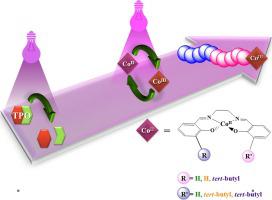European Polymer Journal ( IF 6 ) Pub Date : 2021-09-08 , DOI: 10.1016/j.eurpolymj.2021.110757 Larissa F. Oliveira 1 , Camila Bignardi 1 , Naralyne M. Pesqueira 1 , Beatriz A. Riga–Rocha 1 , Antonio E.H. Machado 2 , Valdemiro P. Carvalho–Jr 1 , Beatriz E. Goi 1

|
In this study, we synthesized the complex [Co(BuSalen)] using the novel tetradentate BuSalen ligand and analyzed its ability as a controlling agent for the photo-induced organometallic-mediated radical polymerization (photo-OMRP) of butyl acrylate (BA) using diphenyl(2,4,6-trimethylbenzoyl)phosphine oxide (TPO) as photo-initiator. BA polymerization with [Co(BuSalen)] reached significant control levels using the [BA]/[CoII]/TPO molar ratio of 600/1/1. The [Co(Salen)] and [Co(Bu2Salen)] complexes were also obtained following literature methods aiming a comparison in the mediating ability in photo-OMRP. [Co(BuSalen)] and [Co(Bu2Salen)] showed better controlling ability, as observed in the copolymerization study (Đ= 2.64, 1.50, and 1.26 for complexes [Co(Salen)], [Co(BuSalen)] and [Co(Bu2Salen)], respectively). Kinetics studies and computational investigations support a reversible termination (RT) mechanism and a tailorable CoII complex reactivity mainly altered by Schiff-base steric factors. Calculated thermodynamic parameters agree with the controlling degree delivered by these complexes, since the polymerization control increases with increasing the ΔG values for the formation of dormant species.
中文翻译:

由Salen型CoII配合物介导的丙烯酸丁酯的光控可逆失活自由基聚合
在这项研究中,我们使用新型四齿 BuSalen 配体合成了配合物 [Co(BuSalen)],并分析了其作为丙烯酸丁酯 (BA) 光诱导有机金属介导自由基聚合 (photo-OMRP) 控制剂的能力。二苯基(2,4,6-三甲基苯甲酰基)氧化膦(TPO)作为光引发剂。BA 与 [Co(BuSalen)] 的聚合达到了显着的控制水平,使用 [BA]/[Co II ]/TPO 摩尔比为 600/1/1。[Co(Salen)] 和 [Co(Bu 2 Salen)] 配合物也是按照文献方法获得的,目的是比较 photo-OMRP 的介导能力。[Co(BuSalen)] 和 [Co(Bu 2Salen)] 显示出更好的控制能力,如在共聚研究中观察到的(对于配合物 [Co(Salen)]、[Co(BuSalen)] 和 [Co(Bu 2 Salen)],分别为 Đ= 2.64、1.50 和 1.26 ) . 动力学研究和计算研究支持可逆终止 (RT) 机制和可定制的 Co II复合反应性,主要由席夫碱空间因子改变。计算出的热力学参数与这些复合物提供的控制程度一致,因为聚合控制随着休眠物种形成的 ΔG 值的增加而增加。



























 京公网安备 11010802027423号
京公网安备 11010802027423号